Challenges in Applying System Dynamics to Address Scoping and Estimating Problems
Abstract
1. Introduction
1.1. Problem Statement
1.2. Research Questions
- Why has SD been little used to solve the scoping and estimating problem? The first question is derived based on the following statement from Section 1, paragraph 3, sentence 3: “Using traditional tools such as Gantt Chart, PERT, Kanban Board, Timeline, and Critical Path methods to modify scoping and estimation might affect deadlines for completion budgets and rejection of project changes that might trigger delays or scope creep [2,3,4,5,6]”.
- Is it possible to design a novel SD model using mathematical equations and properly define each function so that project managers would be able to understand? The second question is derived based on the following statement from Section 1, paragraph 4: “Most managers indicated that SD modeling is complicated to design. SD modeling involves mathematical programming, logical decision-making, stock understanding, flaw handling, control elements, computation models, information feedback theory, computer science, causal loop diagrams, quantitative models, feedback loops, and delays. With all these complexities, the project managers avoid using SD modeling to solve scoping and estimation issues [8,9,11,15,16,17,18]”.
- Do project managers have challenges with scoping and estimating issues during project management?
- Are managers familiar with SD, which can help solve scoping and estimating issues during project management?
- Are managers informed about SD during the scoping and estimating phases of project management?
- Can managers use mathematical equations and programming to design and program SD during the scoping and estimating phases?
- Is there any SD available (for example, from Google, journals, or compact discs) for project managers to solve scoping and estimating issues?
- Can the authors develop and implement mathematical equations for the SD model to empower project managers to overcome scoping and estimating challenges?
1.3. Importance of the Study
- Managers will be able to use the SD model instead of traditional tools such as Gantt Chart, PERT, Kanban Board, Timeline, and Critical Path methods to modify scoping and estimation, which may affect completion budget deadlines and rejection of project changes, resulting in delays or scope creep.
- Most managers will be able to create their SD model without worrying about the intricacies. It was previously stated that SD modeling is difficult to design. SD modeling entails mathematical programming, logical decision-making, stock analysis, fault management, control elements, computation models, information feedback theory, computer science, causal loop diagrams, quantitative models, feedback loops, and delays. Due to the difficulties, project managers avoid adopting SD modeling to handle scope and estimate issues. After this study, managers will acquire a good understanding of the scientific procedures needed to design an SD model.
2. Literature Review
3. Research Methodology
- Constructing a review of the literature using the following criteria:
- Search for project scoping and estimating issues.
- Search for why project managers mostly avoid SD modeling to solve project scoping and estimating issues.
- Validate and confirm the problem statement in Section 1.1 using the authors’ material from items [a] and [b].
- Utilizing five project management journal organizations, compare the literature review. A total of 60 papers from each examined publication were referenced to gather information concerning estimation and scoping.
- Gather information concerning estimation and scoping from five project management journal organizations.
- Gathering information on the main reasons why project managers fear using SD modeling to address project scoping and estimating problems was also important. A total of 60 ∗ 5 = 300 papers were gathered from the five project management journal institutes. It is important to highlight that 300 articles were excluded from the literature review section because they were utilized to confirm, support, and validate the study’s problem statement and literature review. The five journals that were utilized are:
- Engineering Project Organization Journal: For information about the Engineering Project Organization Journal, refer to Table 1.
- International Journal of Construction Project Management: For more information about the International Journal of Construction Project Management, refer to Table 1.
- International Journal of Managing Projects in Business: For more information about the International Journal of Managing Projects in Business, refer to Table 1.
- Journal of Engineering and Technology Management: For more information about the Journal of Engineering and Technology Management, refer to Table 1.
3.1. Reasons for Choosing Five Publications
3.2. System Dynamics Model Proposed
- 1.
- Scoping provides the most precise projection of future output amounts. Scoping is used to predict future sales volumes and calculate the expected overhead application rate [7,8,28]. In this study, scoping is defined mathematically in Equations (1) and (2) as and , respectively, where and are scoping for the models in Figure 1 and Figure 2, respectively. Suffixes 1 and 2 are used to differentiate the models. In this study, the Figure 1 model and suffix 1 explain the equations, where is , is , and is . The full explanations of these terms will be discussed in the other items of this section. For example, the explanation of is given in item (“2”) of this section. The same applies to the other equations.Units: MZAR/YearUnits: MZAR/Year
- 2.
- Capacity deterioration (degradation) means an immediate reduction in output, removal from service, or decrease of capacity in the system because of unanticipated failure or an issue that is beyond the project manager’s control [16,29]. In this study, capacity deterioration is defined mathematically in Equations (3) and (4) as and , respectively, where is .Units:Units:
- 3.
- Capacity growth determines a company’s long-term survival, performance, and profitability. Capacity growth helps to attract new employees, acquire assets, and fund investments [2,35]. In this study, capacity growth is defined mathematically in Equations (5) and (6) as and , respectively, where is , and is .Units:Units:
- 4.
- Estimating budget spending is a process that requires a thorough understanding of budget preparation and planning to generate expenditure predictions and advise policymakers on the desirability and feasibility of particular budget proposals [8,36]. In this study, estimated budget spending is defined mathematically in Equations (7) and (8) as and , respectively, where is , and is .Units: MZAR/YearUnits: MZAR/Year
- 5.
- The term “indicated production material” refers to all lists of materials utilized in the product manufacturing process [2,31]. In this study, indicated production material is defined mathematically in Equations (9) and (10) as and , respectively, where is , is , is , and is an estimated budget of the indicated production material.Units: MZAR/YearUnits: MZAR/Year
- 6.
- Material capacity is the maximum quantity of output that a material can generate or provide at any particular time [16,30]. In this study, the indicated material capacity is defined mathematically in Equations (11) and (12) as and , respectively, where is , and is .Units: MZAR/YearUnits: MZAR/Year
- 7.
- Material spending (expenses) includes all costs related to direct materials, manufacturing overhead, and direct labor during the manufacturing process [7,8,28]. In this study, material spending is defined mathematically in Equations (13) and (14) as and , respectively, where is , and is .Units: MZAR/YearUnits:MZAR/Year
- 8.
- Non-material spending refers to production costs that are not accounted for in regular material costs (budgeted) or manufacturing costs [7,8,28]. In this study, non-material spending is defined mathematically in Equations (15) and (16) as and , respectively, where is , and is .Units: MZAR/YearUnits: MZAR/Year
- 9.
- The percentage of material capacity used (PMCU) is the proportion of a material’s potential output that is realized [2,31]. The PMCU of a company can be measured to determine how well it is reaching its potential. In this study, PMCU is defined mathematically in Equations (17) and (18) as and , respectively, where is , and is .Units:Units:
- 10.
- Project material discontinuance is a fault or stoppage in a material’s normal physical properties or structure caused by porosity, fractures, or inhomogeneity [8,33]. In this study, project material discontinuance is defined mathematically in Equations (19) and (20) as and , respectively, where is .Units: MZAR/YearUnits: MZAR/Year
- 11.
- Target project materials are materials selected by material facility operators as those that will be separated from mixed waste material to produce significant quantities of that specific material [8,36]. In this study, target project material is defined mathematically in Equations (21) and (22) as and , respectively, where is .Units:Units:
- 12.
- Estimation (project cost estimation) is the process of approximating expenses, indirect costs, and other types of project costs to develop a budget that meets the financial commitment necessary for a successful project [7,8,28]. In this study, estimation is defined mathematically in Equations (23) and (24) as and , respectively, where is , is , and is .Units:Units:
Testing the Functionality of the Proposed SD Model
3.3. Approach to Collecting Information
3.4. Analysis
- Statistically, the authors will examine concerns with scoping and estimating issues in project management.
- The authors will conduct a statistical analysis to determine how many managers are familiar with SD, which will aid in the resolution of scoping and estimating challenges during project management.
- Statistically, the authors will examine how many managers are aware of scoping and estimation concerns throughout project management.
- Statistically, the authors will determine how many managers can design and develop SD utilizing mathematical calculations and programming.
- The authors will conduct a statistical analysis to determine how many SD models capable of handling scoping and estimating difficulties are available in the public domain (for example, from Google, media outlets, or CDs).
4. Materials Used
- Unlike previous applications, the authors employed the Vensim platform, which includes intuitive graphical interfaces integrated with systems for information management, legible tables, governance, and presentation via commands and animations.
- The authors employed integral equations () due to their statistical advantages in problem-solving and decision-making methodologies.
- Limits equations () help SD designers observe numbers from a distance. Subsequently, an adjustment to a variable is controlled exclusively by its most-significant values.
- The study gained access using functions, also known as lookup table functions. Lookup table functions are very useful for graphically illustrating the functional relationships between two or more variables. Lookup table functions are nonlinear and are difficult to predict.
- Both static and dynamic equations were used. The authors used static and dynamic equations to calculate the balance of the system in equilibrium.
- The study also used the function to select the highest (maximum) value between two numbers.
- Five journals were used in conjunction with Table 1 to get proper and new information related to studies by using the listed databases (resources), keywords, and time frames. Refer to Table 1. The authors used the listed resources, keywords, and time frames from Table 1 to answer the research questions in Section 1.2.
5. Results
5.1. Results to Answer the First Central Question from Section 1.2
5.2. Results to Answer the Second Central Question from Section 1.2
6. Discussion
Answers to the Research Questions
- Do project managers have challenges with scoping and estimating issues during project management? The answer is yes.
- Are managers familiar with SD, which can help to solve scoping and estimating issues during project management? The answer is yes.
- Are managers informed about scoping and estimating issues during project management? The answer is yes.
- Are managers capable of designing and programming SD using mathematical equations and programming? The answer is yes.
- Is there any SD model that is capable of solving scoping and estimating issues that can be freely downloaded from the public domain (for example, from Google, journals, or compact discs)? The answer is no.
- Is it possible to design, program, and give mathematical equations of the SD model that will help project managers solve scoping and estimating challenges? The answer is yes. In this study, the authors provided an SD model to help managers during project management.
7. Conclusions
7.1. The Findings of the Study’s Central Primary Research Question
7.2. The Findings of the Five Secondary Questions
7.3. Future Work
7.4. Limitation of the Study
7.5. Recommendations from the Authors of This Study
Author Contributions
Funding
Institutional Review Board Statement
Informed Consent Statement
Data Availability Statement
Conflicts of Interest
References
- Monnappa, A. Project Scope Management and Its Importance in 2024. 2023, pp. 1–23. Available online: https://www.simplilearn.com/project-scope-management-importance-rar89-article (accessed on 23 February 2024).
- Indeed Editorial Team. 12 Project Management Challenges and How to Solve Them. 2023, pp. 1–8. Available online: https://www.indeed.com/career-advice/career-development/challenges-in-project (accessed on 20 January 2024).
- Rodrigues, A. The Role of System Dynamics in Project Management: A Comparative with Traditional Models. In Proceedings of the Internationa System Dynamics Conference, Wailea, HI, USA, 4–7 January 1994; pp. 1–24. [Google Scholar]
- Tristancho, C. Gantt Chart vs. Kanban Board: Pros, Cons, Similarities & Differences. 2024, pp. 1–34. Available online: https://www.projectmanager.com/ (accessed on 20 April 2024).
- Chappell, E. Gantt Chart vs. Timeline: What Are They and How to Use Them; 2023; pp. 1–15. Available online: https://clickup.com/blog/gantt-vs-timeline/?utm_source=google-pmax&utm_medium=cpc&utm_campaign=gpm_cpc_ar_nnc_pro_trial_all-devices_tcpa_lp_x_all-departments_x_pmax&utm_content=&utm_creative=_____&gad_source=1&gclid=CjwKCAjwufq2BhAmEiwAnZqw8lFNWdklN37taaRU1gOUCEwVP5AzTqhSXdv7--fAPWb3HwbOg60TqhoCmyQQAvD_BwE (accessed on 19 January 2024).
- Stermann, J. System Dynamics Modelling for Project Management. 1992, pp. 1–12. Available online: https://themys.sid.uncu.edu.ar/ (accessed on 16 January 2023).
- Amade, B.; Akpan, E.O.P. Project Cost Estimation: Issues and the Possible Solutions. Int. J. Eng. Tech. Res. 2014, 2, 181–188. [Google Scholar]
- Rumeser, D.; Emsley, M. Key Challenges of System Dynamics Implementation in Project Management. 2016. Available online: https://www.researchgate.net/publication/308739333_Key_Challenges_of_System_Dynamics_Implementation_in_Project_Management (accessed on 19 January 2024).
- Manenzhe, M.T.; Telukdarie, A.; Munsamy, M. Maintenance Work Management Process Model: Incorporating System Dynamics and 4IR Technologies. 2022, pp. 1–32. Available online: https://www.emerald.com/insight/content/doi/10.1108/JQME-10-2022-0063/full/html (accessed on 19 January 2024).
- Amin, S.E.; Abdul-kader, H.M.; Elsaid, A.H. Using Systems Dynamics in Modeling of Dynamic Capabilities: A Review Study. Int. J. Comput. Inf. 2023, 10, 134–141. [Google Scholar] [CrossRef]
- Harms, J.Z.; Malard-Adam, J.J.; Adamowski, J.F.; Sharma, A.; Nkwasa, A. Dynamically Coupling System Dynamics and SWAT+ Models using Tinamït: Application of Modular Tools for Coupled Human—Water System Models. Hydrol. Earth Syst. Sci. 2023, 27, 1683–1693. [Google Scholar] [CrossRef]
- Crookes, D.J.; Blignaut, J.N.; de Wit, M.P.; Esler, K.J.; Maitre, D.C.L.; Milton, S.J.; Mitchell, S.A.; Cloete, J.; Abreu, P.d.; Fourie, H.; et al. System Dynamic Modelling to Assess Economic Viability and Risk Trade-Offs for Ecological Restoration in South Africa. J. Environ. Manag. 2023, 120, 138–147. [Google Scholar] [CrossRef]
- Bugalia, N.; Maemura, Y.; Ozawa, K. A System Dynamics Model for Near-Miss Reporting in Complex Systems. Saf. Sci. 2021, 142, 105368. [Google Scholar] [CrossRef]
- Nasution, F.B.B.; Bazin, N.E.N. Public Policymaking Framework Based on System Dynamics and Big Literature Review. Int. J. Syst. Dyn. Appl. 2017, 7, 38–53. [Google Scholar]
- Ghaffarzadegan, N.; Lyneis, J.; Richardson, G.P. How Small System Dynamics Models Can Help the Public Policy Process. Syst. Dyn. Rev. 2011, 27, 22–44. [Google Scholar] [CrossRef]
- Eidin, E.; Bielik, T.; Touitou, I.; Bowers, J.; McIntyre, C.; Damelin, D.; Krajcik, J. Thinking in Terms of Change over Time: Opportunities and Challenges of Using System Dynamics Models. J. Sci. Educ. Technol. 2024, 33, 1–28. [Google Scholar] [CrossRef]
- Mashaly, A.F.; Fernald, A.G. Identifying Capabilities and Potentials of System Dynamics in Hydrology and Water Resources as a Promising Modeling Approach for Water Management. Water 2020, 12, 1432. [Google Scholar] [CrossRef]
- Phan, T.D.; Bertone, E.; Stewart, R.A. Critical Review of System Dynamics Modelling Applications for Water Resources Planning and Management. Clean. Environ. Syst. 2021, 2, 100031. [Google Scholar] [CrossRef]
- Aceron, J. Top 3 Project Management Challenges and How to Overcome Them. In Nimble Humanize Work; 2023; pp. 1–17. Available online: https://www.nimblework.com/blog/project-management-challenges/ (accessed on 23 February 2024).
- Fastercapital Project Scope: Project Scope and Its Impact on Accurate Cost Estimation. 2024, pp. 1–299. Available online: https://fastercapital.com/content/Project-scope--Project-Scope-and-Its-Impact-on-Accurate-Cost-Estimation.html (accessed on 23 February 2024).
- Naybour, P. Projects Fail Because of Poor Estimates in the Planning Phase. In Parallel Project Training; Parallel Project Training, 2015; pp. 1–5. Available online: https://www.parallelprojecttraining.com/blog/why-projects-fail-poor-estimates-planning-phase/ (accessed on 13 January 2024).
- Garg, D. Characterizing Project Scope Attributes and Their Influence on the Software Estimation Process; Massachusetts Institute of Technology: Cambridge, MA, USA, 2023; pp. 1–72. [Google Scholar]
- Masombuka, S.S.N.; Thani, X.C. Challenges and Successes of the Government-wide Monitoring and Evaluation System. Sabinet African J. 2023, 31, 146–172. [Google Scholar]
- Department of Planning, Monitoring, and Evaluation. Revised Annual Performance Plan 2022/2023; Department of Planning, Monitoring, and Evaluation: La Conner, WA, USA, 2023; pp. 1–136. [Google Scholar]
- Chellapa, S. 5 Teamwork Challenges Every Team Encounters! Engagedly.com. 2023, pp. 1–5. Available online: https://engagedly.com/blog/5-common-teamwork-challenges-every-team-encounters/ (accessed on 23 March 2024).
- Benarkuu, G.G.; Katere, E. The Effects of Dynamic Team-Building Intervention on Internal Communication in the Hospitality Industry in Sunyani Municipality, Ghana. World J. Adv. Res. Rev. 2023, 18, 1567–1575. [Google Scholar] [CrossRef]
- Althiyabi, T.; Quresh, M.R.J. Predefined Project Scope Changes and its Causes for Project Success. Int. J. Softw. Eng. Appl. 2021, 12, 45–56. [Google Scholar] [CrossRef]
- Sadek, A. System Dynamics Approach for Whole Life Cycle Cost Modeling of Residental Building Projects in the United Arab Emirates. J. Entrep. Proj. Manag. 2021, 6, 49–71. [Google Scholar]
- Tiruvengadam, N.; Elizondo-Noriega, A.; Beruvides, M. Opportunities for System Dynamics Implementation in Project Management Evaluation. In Proceedings of the Portland International Conference on Management of Engineering and Technology, Portland, OR, USA, 7–11 August 2022; pp. 1–17. [Google Scholar]
- Nakhleh, E. Relationship between Time Estimation, Cost Estimation, and Project Performance; Walden University: Minneapolis, MN, USA, 2019; pp. 1–1200. [Google Scholar]
- Odeh, A.; El-Hassan, A.; Abushakra, A.; Keshta, I. A Model for Estimating the Scope of the Project: A Pilot Study. Int. J. Entrep. 2021, 25, 1–10. [Google Scholar]
- Lane, D.C.; Rouwette, E.A.J.A. Towards a Behavioral System Dynamics: Exploring its Scope and Delineating its Promise. Eur. J. Oper. Res. 2023, 306, 777–794. [Google Scholar] [CrossRef]
- Calderon-Tellez, J.A.; Bell, G.; Sato, C.; Herrera, M.M. Exploring Project Management through System Dynamics Modeling: Revisiting the Importance of the Rework Cycle; Cladea: Santiago de Surco, Peru, 2022; pp. 1–22. [Google Scholar]
- Bozzani, F.M.; Diaconu, K.; Gomez, G.B.; Karat, A.S.; Kielmann, K.; Grant, A.D.; Vassall, A. Using System Dynamics Modeling to Estimate the Costs of Relaxing Health System Constraints: A Case Study of Tuberculosis Prevention and Control Interventions in South Africa. Health Policy and Planning. Health Policy Plan. 2022, 37, 369–375. [Google Scholar] [CrossRef]
- Becker, L.; Nilsson, N. Exploring the Impact of Project Size on Effort Estimation: A Case Study of Large Software Development Projects. Master Sci. Ind. Manag. Eng. 2021, 371, 1–21. [Google Scholar]
- Highway Knowledge Portal. Project Cost Estimation and Management; 2023; pp. 1–27. Available online: https://kp.uky.edu/knowledge-portal/articles/project-cost-estimation-and-management/ (accessed on 23 January 2024).
- Bingham, E.; Gibson, G.E.; Asmar, M.E., Jr. Best Practices in Preconstruction Services for Transportation Projects. Eng. Proj. Organ. J. 2018, 8, 1–12. [Google Scholar]
- HBR Editors. The Four Phases of Project Management; HBR: Baltimore, MD, USA, 2016; pp. 1–10. [Google Scholar]
- Nova Science Publisher. International Journal of Construction Project Management. 2021. Available online: https://novapublishers.com/shop/volume-13-issue-2-international-journal-of-construction-project-management/ (accessed on 23 January 2024).
- International Journal of Managing Projects in Business. Owner Capabilities in Social Infrastructure Projects: Towards an Expansion of the Dynamic Capabilities’ Framework. 2019. Available online: https://discovery.ucl.ac.uk/id/eprint/10101944/1/Attached%20standard%20file-.PDF (accessed on 23 January 2024).
- Lai, H.; Chiu, Y.; Liaw, Y. Can External Corporate Venturing Broaden Firm’s Technological Scope? The Role of Complementary Assets. J. Eng. Technol. Manag. 2010, 27, 183–196. [Google Scholar] [CrossRef]
- Calderon-Tellez1, J.A.; Bell, G.; Herrera, M.M.; Lovell, K.; Sato, C. Exploring a Theoretical Framework and System Dynamics Model for Innovation and Sustainability within the Management of Projects Paradigm. Eng. Proj. Organ. J. 2024, 11, 1–31. [Google Scholar]
- Sterman, J.D. System Dynamics Modeling: Tools for Learning in a Complex World. Harv. Bus. Rev. 2001, 43, 8–25. [Google Scholar] [CrossRef]
- Porwal, A.; Parsamehr, M.; Szostopal, D.; Ruparathma, R.; Hawage, K. The Integration of Building Information Modeling (BIM) and System Dynamic Modeling to Minimize Construction Waste Generation from Change Orders. Int. J. Constr. Manag. 2023, 23, 156–166. [Google Scholar] [CrossRef]
- Wolstenholme, E.F. The Use of System Dynamics as a Tool for Intermediate Level Technology Evaluation: Three Case Studies. J. Eng. Technol. Manag. 2003, 20, 193–204. [Google Scholar] [CrossRef]
- Everitt, J. How to Leverage Project Estimation Techniques. Wrike Blog. 2022, pp. 1–8. Available online: https://www.wrike.com/blog/project-estimation-techniques/ (accessed on 13 January 2024).
- Team Asana. What Is the Project Management Triangle and How Can It Help Your Team? Team Asana. 2024, pp. 1–7. Available online: https://asana.com/resources/project-management-triangle (accessed on 23 January 2024).
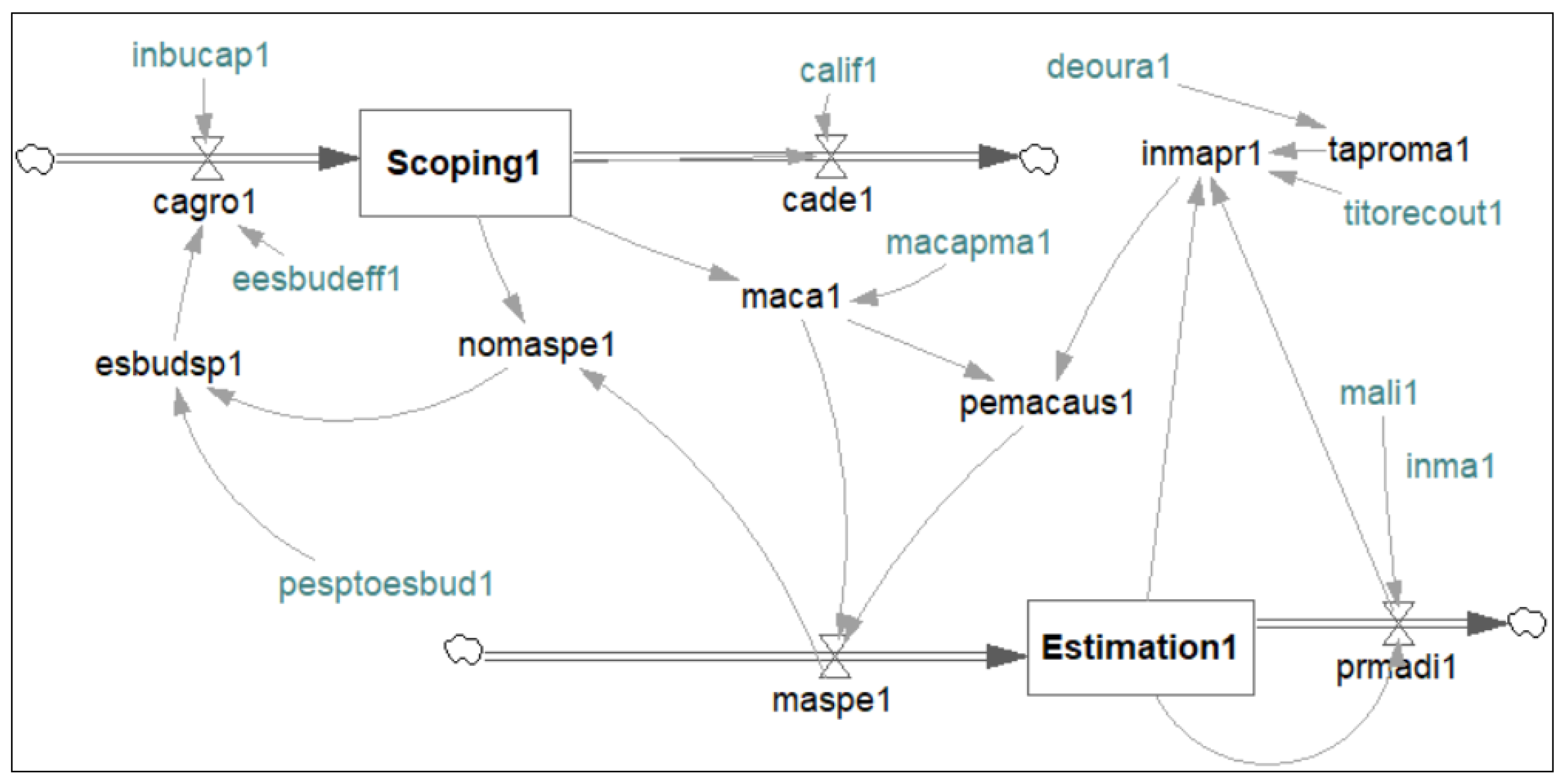
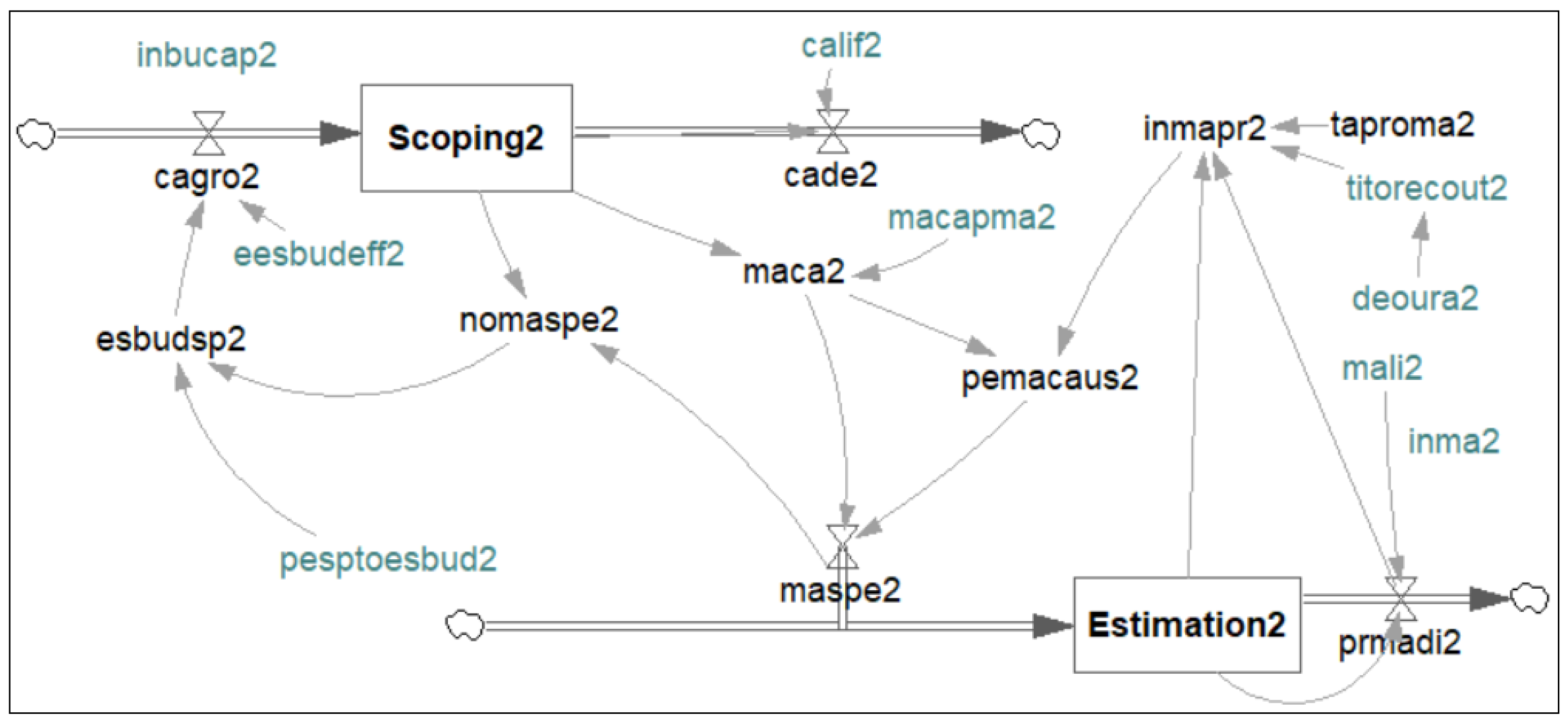






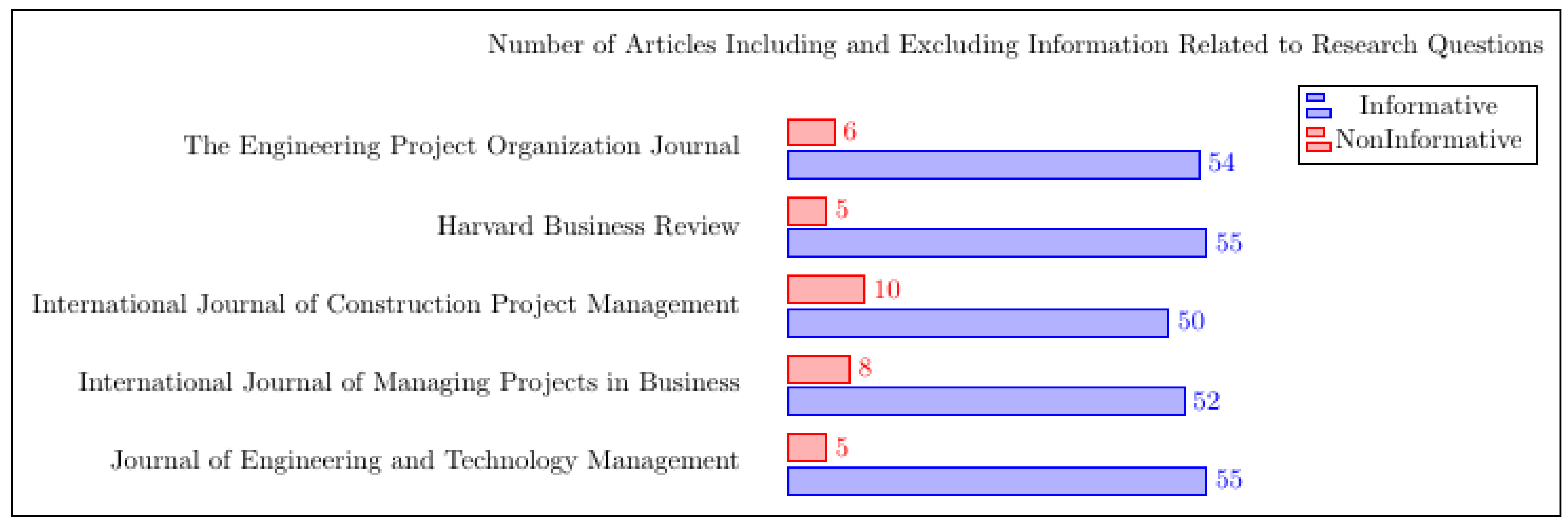

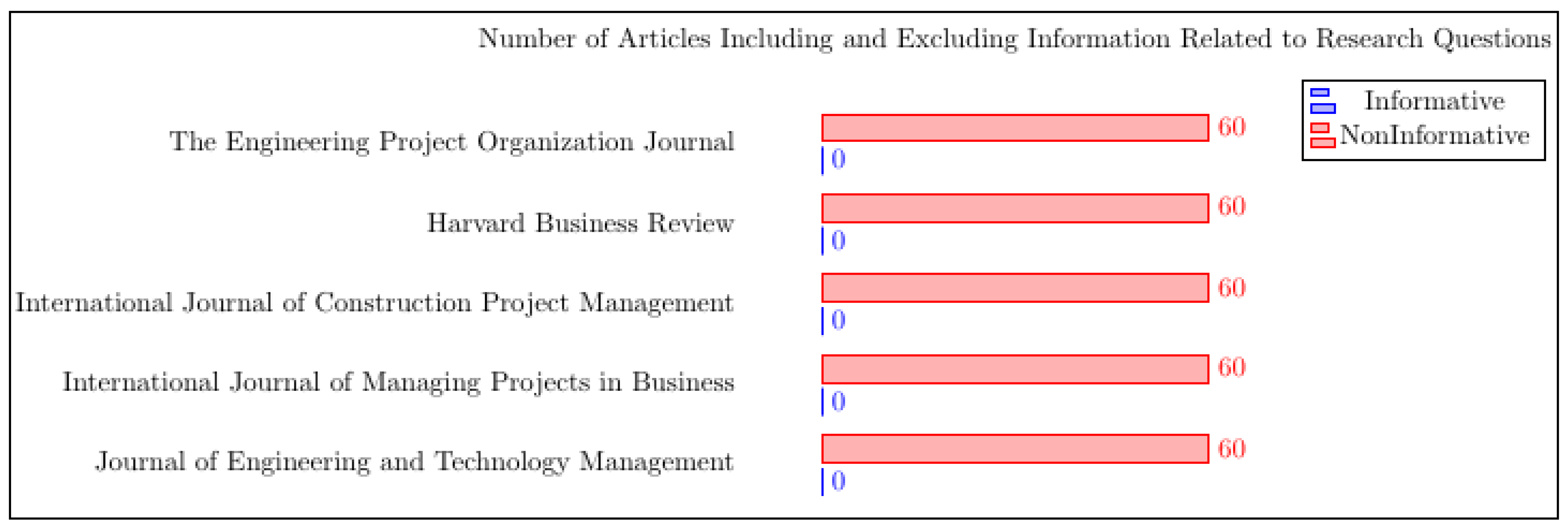
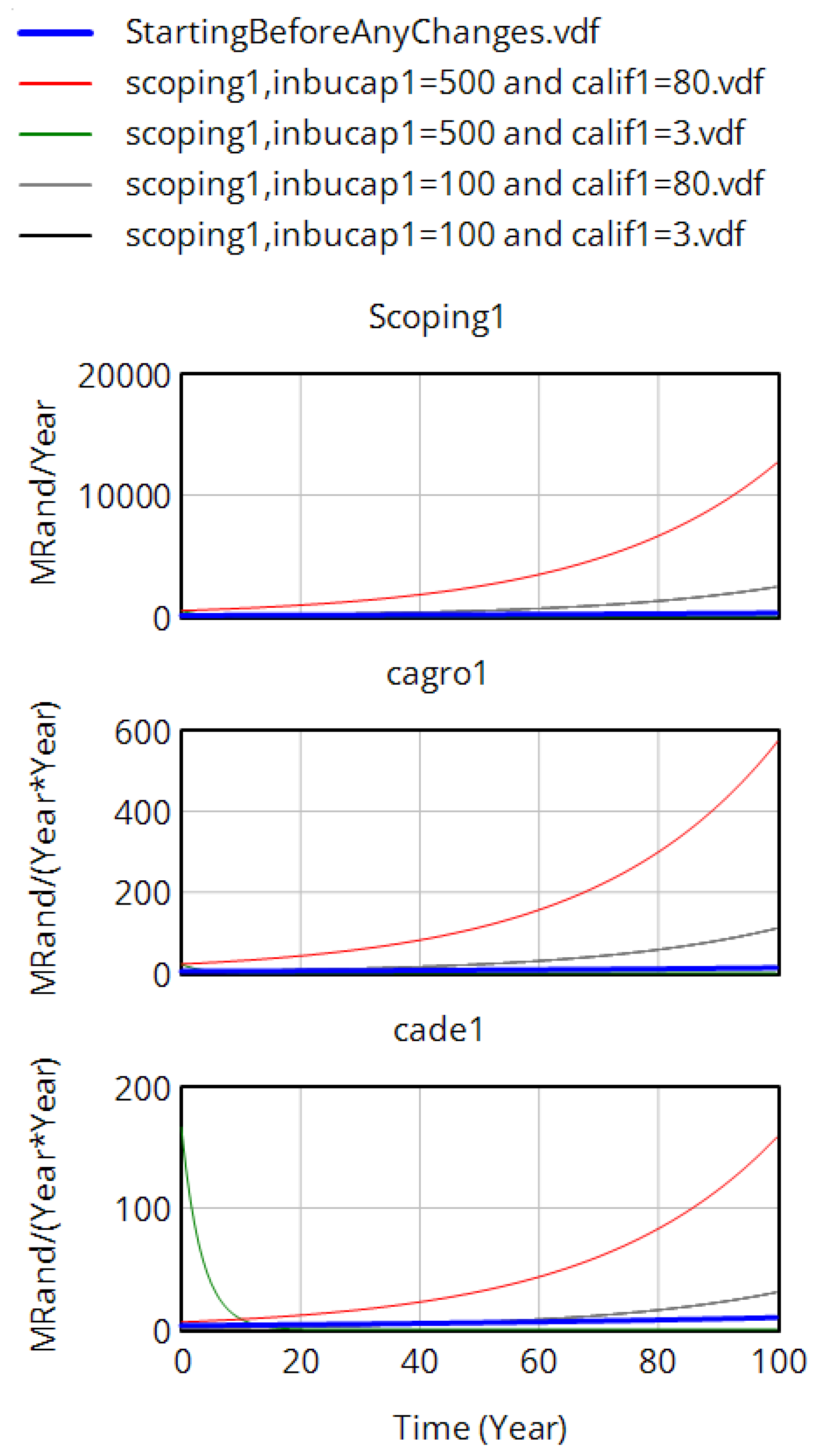
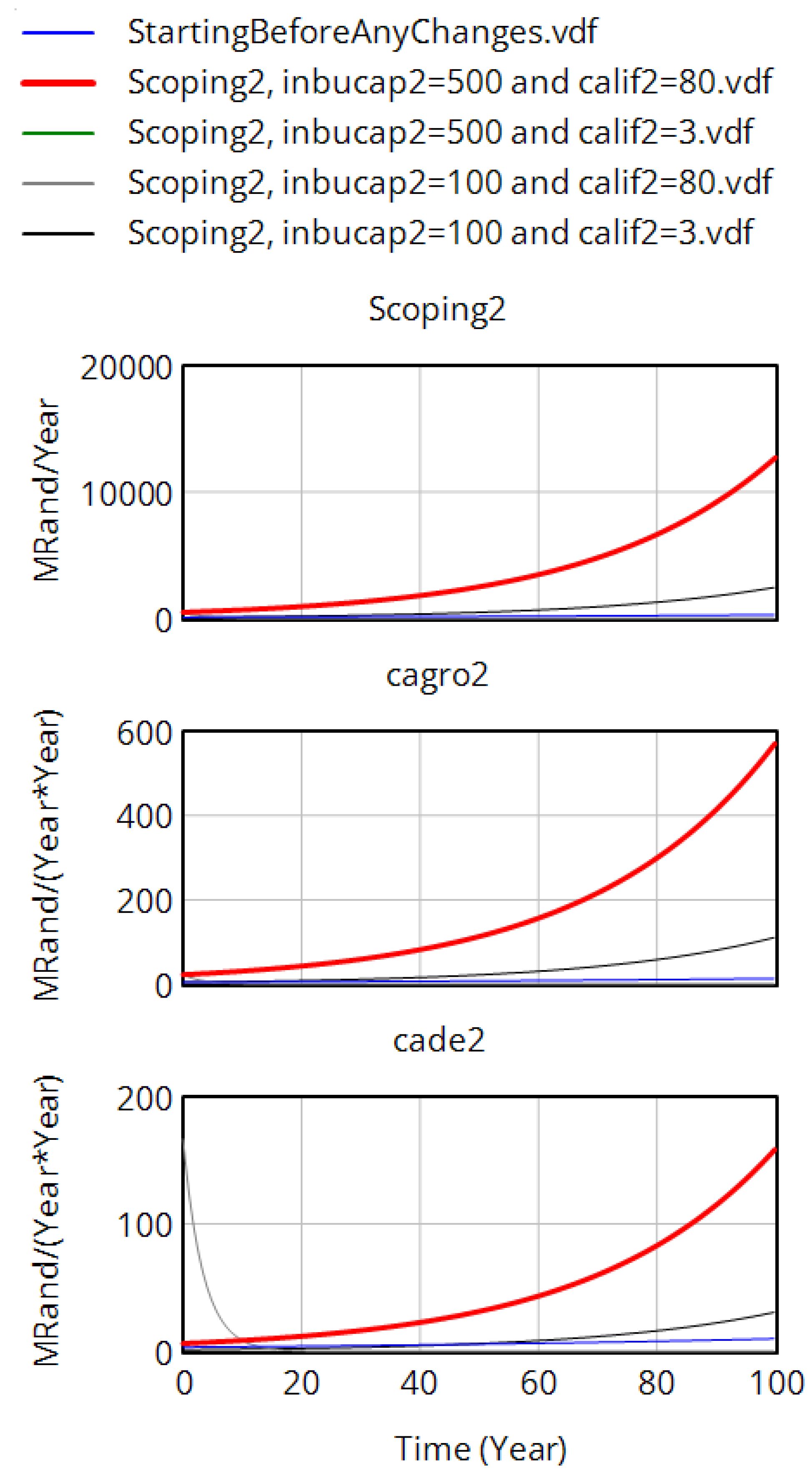
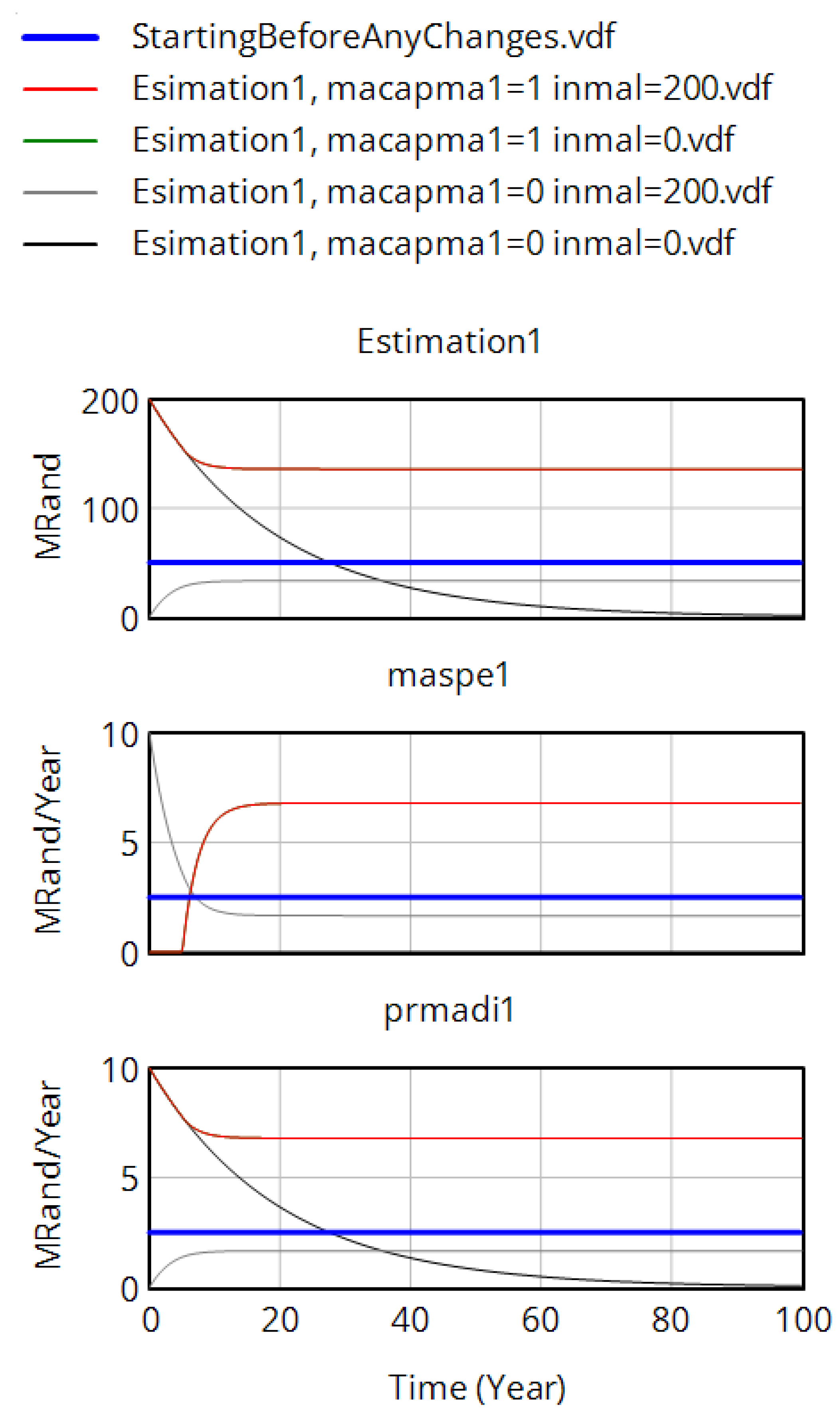
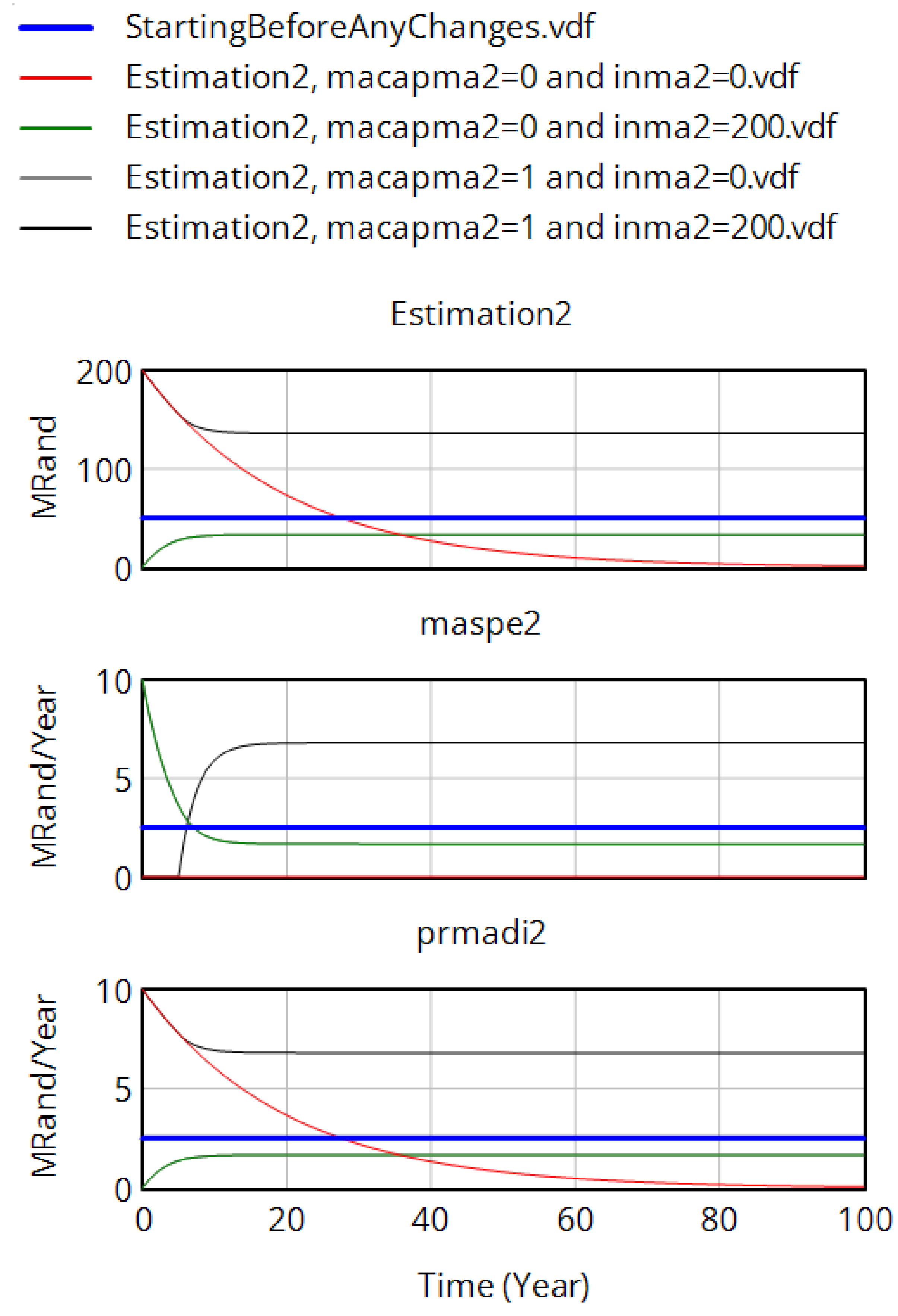
| Institution Name for the Journal | Database or Resource | Keywords | Time Frame |
|---|---|---|---|
| Engineering Project Organization Journal | 1. Taylor Francis using the following link: https://www.tandfonline.com/ (accessed on 15 February 2024) 2. Google Scholar using the following link: https://scholar.google.com/ (accessed on 15 February 2024) 3. SciSpace using the following link: https://typeset.io/ (accessed on 15 February 2024) | 1. Engineering Project Organization Journal 2. Scoping and estimation 3. System dynamics 4. Project management | From years 2019 to 2024 |
| Harvard Business Review | 1. Harvard Business Review database using the following link: https://www.library.hbs.edu/ (accessed on 15 February 2024) 2. Harvard Business Review using the following link: https://hbr.org/ (accessed on 15 February 2024) 3. Kettering University Library using the following link: https://libguides.kettering.edu/ (accessed on 15 February 2024) | 1. Harvard Business Review 2. Scoping and estimation 3. System dynamics 4. Project management | From years 2019 to 2024 |
| International Journal of Construction Project Management | 1. Nova Science Publisher using the following link: https://novapublishers.com/ (accessed on 15 February 2024) 2. Taylor Francis using the following link: https://www.tandfonline.com/ (accessed on 15 February 2024) | 1. International Journal of Construction Project Management 2. Scoping and estimation 3. System dynamics 4. Project management | From years 2019 to 2024 |
| International Journal of Managing Projects in Business | 1. Emerald Publishing using the following link:
https://www.emeraldgrouppublishing.com/ (accessed on 15 February 2024) 2. Google Scholar using the following link: https://scholar.google.com/ (accessed on 15 February 2024) | 1. International Journal of Managing Projects in Business 2. Scoping and estimation 3. System dynamics 4. Project management | From years 2019 to 2024 |
| Journal of Engineering and Technology Management | 1. Science Direct using the following link: https://www.sciencedirect.com/ (accessed on 15 February 2024) 2. Scimago Journal using the following link: https://www.scimagojr.com/ (accessed on 15 February 2024) | 1. Journal of Engineering and Technology Management 2. Scoping and estimation 3. System dynamics 4. Project management | From years 2019 to 2024 |
| Institution Name for the Journal | The Number of Papers Relevant to the Question | Percentage of The Number of Papers Relevant to the Question | Use of 1 Article out of 60 as an Example from the Selected Journal Institution |
|---|---|---|---|
| Engineering Project Organization Journal | 48 | The answer to the Question is Yes. Refer to [37], | |
| Harvard Business Review | 47 | The answer to the Question is Yes. Refer to [38], | |
| International Journal of Construction Project Management | 50 | The answer to the Question is Yes. Refer to [39], | |
| International Journal of Managing Projects in Business | 53 | The answer to the Question is Yes. Refer to [40] | |
| Journal of Engineering and Technology Management | 52 | The answer to the Question is Yes. Refer to [41] |
| Institution Name for the Journal | The Number of Papers that are Relevant to the Question | Percentage of the Number of Papers that are Relevant to the Question | Use of 1 Article out of 60 as an Example from the Selected Journal Institution |
|---|---|---|---|
| Engineering Project Organization Journal | 54 | The answer to the Question is Yes. Refer to [42] | |
| Harvard Business Review | 55 | The answer to the Question is Yes. Refer to [43] | |
| International Journal of Construction Project Management | 55 | The answer to the Question is Yes. Refer to [44] | |
| International Journal of Managing Projects in Business | 50 | The answer to the Question is Yes. Refer to [39] | |
| Journal of Engineering and Technology Management | 52 | The answer to the Question is Yes. Refer to [45] |
| Institution Name for the Journal | The Number of Papers that are Relevant to the Question | Percentage of the Number of Papers that are Relevant to the Question | Use of 1 Article out of 60 as an Example from the Selected Journal Institution |
|---|---|---|---|
| Engineering Project Organization Journal | 55 | The answer to the Question is Yes. Refer to [37] | |
| Harvard Business Review | 52 | The answer to the Question is Yes. Refer to [38] | |
| International Journal of Construction Project Management | 50 | The answer to the Question is Yes. Refer to [39] | |
| International Journal of Managing Projects in Business | 55 | The answer to the Question is Yes. Refer to [40] | |
| Journal of Engineering and Technology Management | 54 | The answer to the Question is Yes. Refer to [41] |
| Institution Name for the Journal | The Number of Papers that are Relevant to the Question | Percentage of the Number of Papers that are Relevant to the Question | Use of 1 Article out of 60 as an Example from the Selected Journal Institution |
|---|---|---|---|
| Engineering Project Organization Journal | 50 | Indeed, yes. However, due to the lack of experience with design, mathematics, and programming, project managers are afraid of making mistakes when utilizing SD. Refer to [42]. | |
| Harvard Business Review | 54 | Indeed, yes. However, due to the lack of experience with design, mathematics, and programming, project managers are afraid of making mistakes when utilizing SD. Refer to [43]. | |
| International Journal of Construction Project Management | 52 | Indeed, yes. However, due to the lack of experience with design, mathematics, and programming, project managers are afraid of making mistakes when utilizing SD. Refer to [44]. | |
| International Journal of Managing Projects in Business | 55 | Indeed, yes. However, due to the lack of experience with design, mathematics, and programming, project managers are afraid of making mistakes when utilizing SD. Refer to [39]. | |
| Journal of Engineering and Technology Management | 55 | Indeed, yes. However, due to the lack of experience with design, mathematics, and programming, project managers are afraid of making mistakes when utilizing SD. Refer to [45]. |
| Institution Name for the Journal | The Number of Papers that are Relevant to the Question | Percentage of the Number of Papers that are Relevant to the Question | Use of 1 Article out of 60 as an Example from the Selected Journal Institution |
|---|---|---|---|
| Engineering Project Organization Journal | 0 | 0/60 = 0% | No downloadable SD model that one can plug and play |
| Harvard Business Review | 0 | 0/60 = 0% | No downloadable SD model that one can plug and play |
| International Journal of Construction Project Management | 0 | 0/60 = 0% | No downloadable SD model that one can plug and play |
| International Journal of Managing Projects in Business | 0 | 0/60 = 0% | No downloadable SD model that one can plug and play |
| Journal of Engineering and Technology Management | 0 | 0/60 = 0% | No downloadable SD model that one can plug and play |
| Theoretical Results Found from Literature Review | Experimental Results Conducted in This Study |
|---|---|
| All five journal institutions and Section 2 included in this study indicated that no SD was applied to solve the issue of scoping and estimation [37,38,39,40,41]. Refer to Table 6 and Figure 11. | An application of an SD model was given. Refer to Section 3.2 of this study. This will help project managers understand better how to design SD models to solve scoping and estimating issues during project management and to understand the mathematical and technical equations needed in SD models. |
| Using traditional tools such as Gantt Chart, PERT, Kanban Board, Timeline, and Critical Path methods to modify scoping and estimation might affect deadlines for completion budgets and cause the rejection of project changes that might trigger delays or scope creep [2,3,4,5,6]. | Unlike the previous application, the authors employed the Vensim platform, which includes intuitive graphical interfaces integrated with systems for information management, legible tables, governance, and presentation via commands and animations. This will help project managers better grasp how to create SD models to tackle scoping and estimating difficulties during project management as well as to create the mathematical and technical equations required for SD models. This will give project managers a better understanding of how to develop SD models to address scoping and estimating issues throughout project management as well as to develop the mathematical concepts and scientific equations required for SD models. |
| From Section 2, no one has ever indicated the definition and purpose of integral equations in an SD model. | The authors employed integral equations () due to their offer of statistical advantages in problem-solving and decision-making methodologies. This will provide project managers with a greater understanding of how to create SD models to resolve scoping and estimating difficulties throughout the project lifecycle as well as to develop the mathematical principles and scientific equations essential for SD models. |
| From Section 2, there are no explanations about limits equations. | Limits equations () help SD designers observe numbers from a distance. Subsequently, an adjustment to a variable is controlled exclusively by its most significant values. This will give administrators of projects a better understanding of how to develop SD models to handle scoping and estimating problems throughout the project’s lifespan as well as to develop the principles of mathematics and scientific formulae required for SD models. |
| From Section 2, static and dynamic equations were not mentioned. In this study, static and dynamic equations were used. | The authors use static and dynamic equations to calculate the balance of the SD model in equilibrium. This will provide the project team with an improved awareness of how to create SD models to address scoping and estimating issues throughout the project’s lifecycle as well as to develop the mathematical principles and scientific procedures essential for SD models. |
| From Section 2, no mathematical expressions were discussed. | The study also used the function to select the highest (maximum) value between two numbers. |
| Most project managers dislike SD modeling because of its complexity, especially if they lack engineering, programming, mathematical analysis, or IT expertise [8,10,14]. SD modeling necessitates mathematical programming, logical decision-making, stock understanding, flaw handling, control elements, computation models, information feedback theory, computer science, causal loop diagrams, quantitative models, feedback loops, and delays [9,11,15,18]. For a summary explanation, refer to Table 5 and Figure 10. | The authors of this paper tackle scoping and estimating problems with SD modeling. In this study, the authors developed an SD model to solve problems of scoping and estimation. Firstly, the authors drew a first SD model, followed by a second SD model, before giving the units. Refer to Section 3.2 for more details. Secondly, the authors connected the two SD models as follows: (1) making a connection from to and (2) making a connection from to . NOTE: The names in Figure 1 and Figure 2 are abbreviated for clear visibility of the SD model drawn. For the full explanation, refer to Section 3.2. For example, means capacity growth 2, and so on. The currency in South Africa is ZAR; hence, is used as the units. stands for million ZAR. Refer to Section 3.2. |
| In Section 2, from five selected journals, static and dynamic equations were not mentioned for solving scoping and estimation problems. | In this research, static and dynamic equations were used. Refer to Section 4 for static and dynamic equation functionality and advantages in SD modules. |
Disclaimer/Publisher’s Note: The statements, opinions and data contained in all publications are solely those of the individual author(s) and contributor(s) and not of MDPI and/or the editor(s). MDPI and/or the editor(s) disclaim responsibility for any injury to people or property resulting from any ideas, methods, instructions or products referred to in the content. |
© 2024 by the authors. Licensee MDPI, Basel, Switzerland. This article is an open access article distributed under the terms and conditions of the Creative Commons Attribution (CC BY) license (https://creativecommons.org/licenses/by/4.0/).
Share and Cite
Muthavhine, K.D.; Sumbwanyambe, M. Challenges in Applying System Dynamics to Address Scoping and Estimating Problems. Sustainability 2024, 16, 7892. https://doi.org/10.3390/su16187892
Muthavhine KD, Sumbwanyambe M. Challenges in Applying System Dynamics to Address Scoping and Estimating Problems. Sustainability. 2024; 16(18):7892. https://doi.org/10.3390/su16187892
Chicago/Turabian StyleMuthavhine, Khumbelo Difference, and Mbuyu Sumbwanyambe. 2024. "Challenges in Applying System Dynamics to Address Scoping and Estimating Problems" Sustainability 16, no. 18: 7892. https://doi.org/10.3390/su16187892
APA StyleMuthavhine, K. D., & Sumbwanyambe, M. (2024). Challenges in Applying System Dynamics to Address Scoping and Estimating Problems. Sustainability, 16(18), 7892. https://doi.org/10.3390/su16187892


_Li.png)



